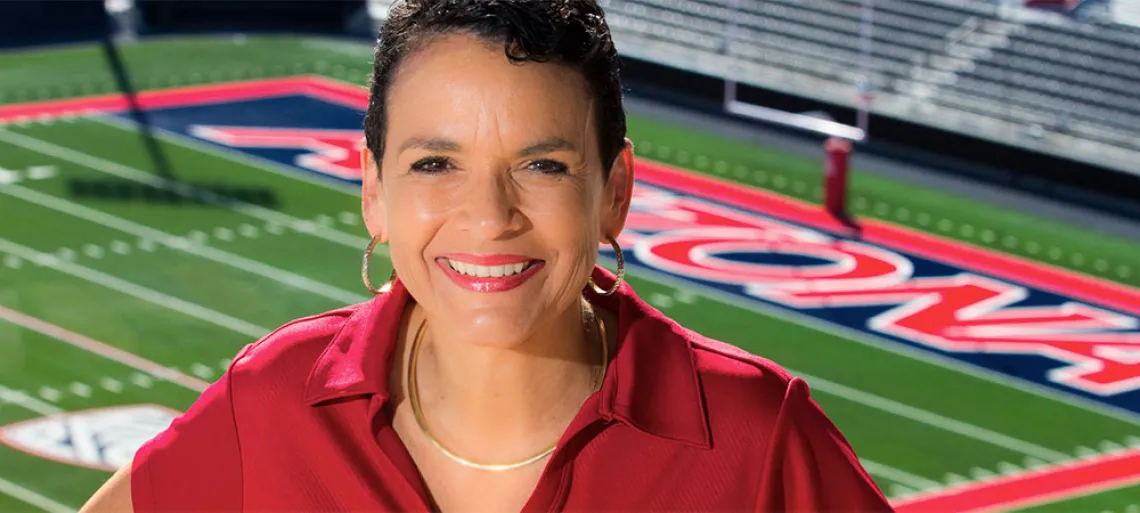Rivalries Affect Risk in Sports, Business: Eller Professor of Management and Organizations Lisa Ordóñez

Researchers studied thousands of NFL plays and used college football rivalries to test behaviors about how rivalry affects risk-taking. They found out that on the field or in the boardroom, rivalry can cause you to make riskier decisions.
Baltimore Ravens fans remember the game that was played during Week 12 of the 2012 National Football League season. Los Angeles Chargers fans never will forget it. With 1:58 left in the game, the then-San Diego Chargers led, 13-10, and the Ravens' offense was facing a dire situation: fourth down and 29 yards to go on their own 37-yard line.
When most teams would have punted in that situation, the Ravens' quarterback took a huge risk and tossed the ball to a running back at the line of scrimmage. No fewer than eight San Diego players were in position to tackle in those 29 yards and the Chargers would have won the game. Instead, an unlikely first-down conversion led to a game-tying field goal and then an overtime win for the Ravens, contributing to a regular season record of 10-6. The team went on to win the Super Bowl.
Potentially risky fourth-down plays such as this one are part of a unique dataset analyzed by researchers from three universities, including the University of Arizona. Their paper, "Going for it on fourth down: Rivalry increases risk-taking, physiological arousal and promotion focus," has been accepted to the Academy of Management Journal. The research project studied the interactions between rival and non-rival teams on fourth downs in more than 2,000 NFL games from 2002-2010.
"Our hypothesis was if you're playing or competing against a rival, you're more likely to take risks," said Lisa Ordóñez, vice dean of the Eller College of Management and the person responsible for securing the large and comprehensive dataset.
Ordóñez and her colleagues — Christopher To and Gavin J. Kilduff at New York University's Stern School of Business and Maurice Schweitzer at the Wharton School at the University of Pennsylvania — identified two risky behaviors on the gridiron: going for it on fourth down instead of punting and going for a two-point conversion by run or pass instead of the extra-point kick.
"In both cases, we found that when you're playing a rival you're more likely to go for it," Ordóñez said. "You're more likely to go for it on fourth down, you're more likely to go for the two-point conversion. We thought that was really interesting, but it really just got us started."
Seeking to add experimental evidence to the archival NFL records, Ordóñez invited her co-authors to the Eller laboratory for a face-to-face experiment using college students, who often are passionate about their school's football team.
"In this lab study, we measured people's galvanic skin response and their heart rates," Ordóñez said. "In addition, we wanted to look at their actual behavior, so we asked them to perform a task where they could make risky decisions or not."
Volunteers were asked to wear something representing their favorite school's team — and, as expected, the UA student participants showed up in Wildcat gear. Each volunteer was paired with a "confederate," an MBA student who posed as a fan of a rival (Arizona State University) or non-rival (University of Colorado) team. Participants then competed against the confederate in a computerized risk-taking game.
"The reaction was visceral," Ordóñez said. "When they saw that ASU hat, their nose flared, their claws came out, they made some snide comments like, 'What are you wearing that hat for?' Their heart rate went up; their galvanic skin response went up; they were agitated physiologically. Then, when we looked at their behavior on the task, they also took more risks. They made riskier decisions."
Ordóñez's relational rivalry research adds a new dimension to existing business rivalry research, much of which has been headed by Kilduff. Risk taking already has been shown to positively or negatively affect businesses and employees, depending on the context. Understanding how rivalries increase risk taking can provide managers with the information they need to evaluate whether rivalry will be beneficial or harmful for the performance of their organizations and their employees.
"It was great working with my co-authors at two different schools. We're all researchers in management, so of course we're not doing a study just about football," said Ordóñez, who grew up with four athletic brothers and, as a result, "lives, eats and breathes" football.
"It was a lot of fun to do the study, as well as get some interesting results," she said. "The larger issue is rivalry in general, and looking at companies and their competitors as rivals."
Which companies are more likely to take on risky decisions and when? The answer might just lie in who they're facing across the line of scrimmage.
Top photo: Dr. Lisa Ordóñez at Arizona Stadium, by Bob Demers, courtesy UA News.

